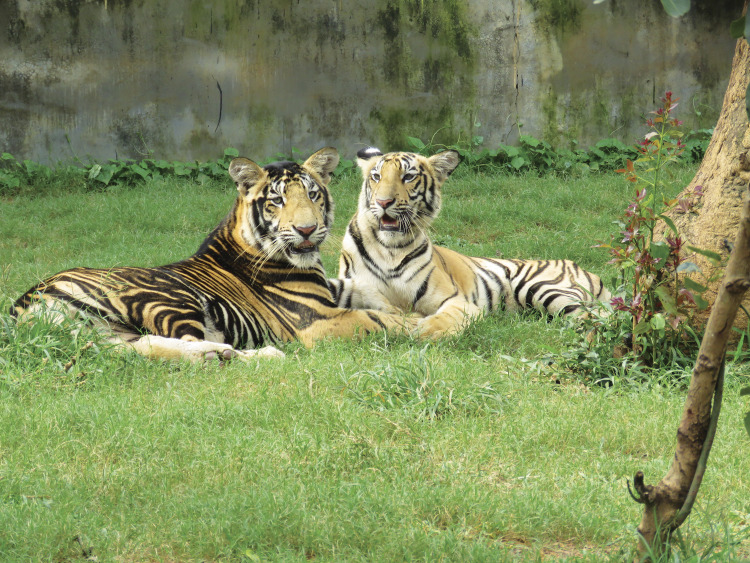POPULATION BIOLOGY
A captive pseudomelanistic tiger and its normal sibling at Nandankanan Biological Park, Bhubaneswar, India.
Genetic basis of rare stripe pattern in tigers
Endangered species often live in fragmented populations in which the frequency of recessive genetic variants may increase following a population bottleneck, a process known as genetic drift. Few studies have measured genetic drift in small, isolated, and endangered populations, especially for genes associated with visible phenotypes. Vinay Sagar et al. investigated the genetic basis of pseudomelanism, which is characterized by unusually broad and fused stripes, in tigers (Panthera tigris) from the Similipal Tiger Reserve in eastern India. The authors used whole-genome sequence data and known pedigrees from captive pseudomelanistic tigers to identify a recessive, single-nucleotide mutation in the Taqpep gene, which is also associated with coat patterns in other cat species. Next, the authors used noninvasive sampling and published data to measure the frequency of the Taqpep mutation in wild tigers living within and outside Similipal. The mutant Taqpep allele had a frequency of 58% among the 12 tigers sampled within Similipal but was absent in the other 395 tigers analyzed. Population genetic data and simulations suggest that inbreeding and genetic drift could explain the frequency of pseudomelanism in Similipal. According to the authors, the pseudomelanistic tigers of Similipal offer an opportunity to observe rapid evolutionary change. — M.H.
ECOLOGY
Commonalities in diverse coral reef food webs
The species composition of coral reefs, which are among the most diverse ecosystems, varies with physical location. To uncover how individual interactions between multiple species affect reef ecosystems and identify general characteristics of food webs within coral reefs, Chloé Pozas-Schacre et al. constructed network models and analyzed gut contents from reef fishes in six different regions across the globe. Using the data, the authors built six consumer resource networks, or food webs, representing 688 species of fish and 649 types of prey. Across the six networks, the authors report, more than half of the predator–prey interactions, measured by prey item frequency or volumetric percentage, were shared. The results also showed that specialists that consume a diet of limited prey dominate coral reef food webs. According to the authors, the concentration of highly specialized predator–prey relationships suggests that coral reef food webs are vulnerable to individual species loss and that disturbance of reef fish communities could harm tropical reef health. — T.H.D.
GENETICS
Nenets dogs of the Siberian Arctic beside a dogsled in the Iamal-Nenets region of Siberia.
Genetic ancestry of Siberian dogs
Human communities in Arctic Siberia have lived with dogs for over 9,500 years. Genomic evidence suggests Samoyedic-speaking peoples of Northwest Siberia have received limited gene flow from neighboring groups, but the genetic ancestry of Siberian dogs is unclear. Tatiana Feuerborn, Alberto Carmagnini, et al. sequenced DNA from 20 ancient and historical Siberian and Eurasian Steppe dogs to reconstruct the genetic history of Siberian dog populations. The authors compared the results with publicly available genetic data from ancient and modern canids. The results suggest that Siberian dog populations have experienced significant genetic continuity over the last 9,500 years. Siberian dogs evolved in near-isolation until at least 7,000 years ago. In the past 2,000 years, Siberian dogs experienced increasing levels of genetic admixture from Western Eurasian sources. The authors also found that modern Samoyed and Siberian Husky dog breeds share ancestry with ancient Siberian dogs. According to the authors, the introduction of new genetic material to Siberian dog populations coincides with the introduction of glass and metal items to the archaeological records of Northwestern Siberia, suggesting that the region was connected to a large trade network despite its relative isolation. — M.H.
APPLIED MATHEMATICAL SCIENCES
Narrow, crowded sidewalks make social distancing difficult in many cities. Using an algorithm, computer scientists offered a path to better planning for cars and pedestrians. Image credit: Shutterstock/Aleksandr Ozerov.
An algorithm suggests a sidewalk-space redesign to make cities safer for pedestrians
Posted on September 17, 2021
Amy McDermott
A recent study in Communications Physics is among the first to systematically analyze whole city networks of spider-webbing roads and sidewalks. Examining 10 global cities, including Boston, Paris, and New York, researchers created an algorithm that could help planners choose certain sidewalks to expand for walking or biking, while minimizing disruption to car traffic. “There is a lot of interest in redesigning cities toward pedestrians,” says computer scientist Daniel Rhoads, a graduate student at the Open University of Catalonia in Barcelona. “What’s missing is a methodology to propose these changes.”





